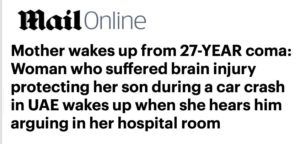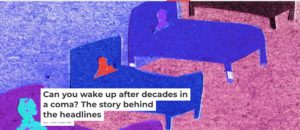
Module 3: Representing Diagnosis and Prognosis
3.3 Reporting recovery
In the previous unit we explored ‘imagined awakenings’ in movies and soap opera. Such scenarios also capture the imagination of news journalists and of media consumers. There are several well-documented examples of unexpected changes in patient’s conditions long after any such change could have been predicted. These cases attract international headlines and circulate repeatedly on social media. Terry Wallis is one particularly famous and well documented case. After being mute and in a minimally conscious state for 19 years he began to be able to talk. His case features in “The Man Who Slept for 19 years”. An update on his condition was presented in 2014 and you can read a moving account from his family here: https://arkansaslife.com/reconnecting-terry/

Such cases can be a beacon of hope for families who believe their relative would have wanted to hold on for even the most remote chance of some level of recovery. Media representation of changes (even after a very long time) challenge the idea that patients inevitably ‘plateau’ in their recovery and encourage families to fight for ongoing access to stimulation and rehabilitation. Such accounts are also important to healthcare professionals devoted to enabling the best possible level of recovery for the patients they care for.
It can be very important to present a realistic and/or ‘positive’ idea of what recovery from a vegetative state (for a short time) or minimally conscious state (even after a longer time) can look like. This is well represented by one of the key support groups for families facing serious brain injury: ‘BIG’ – you can see a moving video about their work here. Their promotion video includes film of some of their relatives who did recover full consciousness – note Stewart’s mother talking about how they can have laughter together and how her son has a sense of humour. Keeping hope, but being realistic, is key to messages from organisations such as BIG.
Alongside understanding cases such as Terry Wallis (after a long time in MCS) or Steward (whose recovery trajectory over the first year after injury is much more typical) it is important to be sceptical of some accounts in the media. Sometimes the media misrepresents the level or likelihood of recovery, and families may feel they have been tricked into holding on to ‘false hope’ by a chimera promoted by the media.
If a celebrity is injured there may be an initial flurry of interest in any sign of recovery – with a move ‘off a ventilator’ or ‘out of a coma’ or ‘going home’ all being interpreted as some sign of significant progress. Such moves may however simply indicate that the patient is becoming increasingly physiologically stable, but no progress is being made neurologically. People who remain in long term disorders of consciousness (or recover but with remaining profound neurological problems) often disappear from sight but reporting may have left anyone reading the newspapers with the impression that they ‘woke up’.
Watch the clip below to hear Cathy describe how she and her parents related to such stories when her own brother was left in a vegetative state after being hit by a car. She also talks about how a local paper falsely implied that her brother was regaining consciousness. He, in fact, eventually died after many years in a vegetative state.
Alongside such false reports there are, however, reports of genuinely unexpected recoveries (depending on how you define ‘recovery’), and these may become a media sensation, especially if they have a dramatic personal angle and human interest story behind them. Such accounts may need careful writing or reading to avoid audiences being left with an exaggerated sense of what happened however.
Activity 1 (Estimated time 20 mins)
You may remember news coverage of a case in 2019 about a woman from the United Arab Emirates.
a) Read one of the original reports about this case: “Mother wakes up from 27-year coma”

b) Then read this blog: “Can you wake up after decades in a coma?”

c) Then consider the following questions
- Is there anything you could take from this blog that might be useful for next time you see a media report about an unexpected recovery?
- If you are a journalist how does the information in the blog impact on how you might investigate or write up a story like this in the future?
- If you are a healthcare professional, is there anything you can take from the blog that would be useful in your conversations with families?
- What may be the policy implications for ensuring the right level of support for patients given what might have happened in this case?
Activity 2
Please add comments about the blog to the form below and skim to see what others have written and respond if you wish. You can also post questions here too – for other students (or for the course tutor if you are working with one).
Activity 3, optional. Reflect on one family's account of recovery to full consciousness
When a patient recovers consciousness and ‘goes home’ that is often the end of the story for media coverage and sometimes for the professional team involved in rehabilitation and assessment. Listen to one family describing their experience of fighting for treatment for their loved one and their pride in how he ‘proved the doctors wrong’ in emerging from his unconscious state and making some progress.
Watch the half dozen or so short clips from the interview with the brothers and sister-in-law of the injured individual here
https://www.healthtalk.org/family-experiences-vegetative-and-minimally-conscious-states/peter-olga-andrew
Write a reflective pice (300 words) on what you learned from listening to these extracts from the interview and how it is different from, or similar to, media accounts.
9 Comments
Leave a reply
You must be logged in to post a comment.


I wrote this blog very quickly, it was hard as an academic to publish something which tried to take my general expertise and apply it to an unfolding news story where I don’t have direct access to information. I was also concerned as, of course, this is a very personal story for a family involved. My tendency will always be to want to research specifics in depth. News cycles don’t allow for that time to research and reflect. But publishing this blog meant I was able to contribute to debate at the time – and I contributed to various radio and newspaper reporting, trying to add some caveats and questions to be considered.
As a healthcare worker it’s important to be aware of stories in the media and how they may give potentially unrealistic expectations or hopes to families. Brain injury is complex and a different experience for everyone and as the media don’t always portray the situation realistically I think it’s important to be sceptical of such awakenings. I think the blog explores the event very well especially when there was limited and conflicting information. I may well refer back to it if I’m ever in a position where a family member refers to such stories in the media.
I agree, I think the blog explores how to pick out the key points of a media article and think critically about the accuracy of what is being said. I think it may be useful to use to help support family members who find such articles and refer to them when discussing their own loved ones situation.
I think it also highlight the need to ensure that all patients in a disorder of consciousness are given the opportunity to undergo specialist assessment with healthcare professionals who are experienced in this area, to try and ensure that conditions are optimised to support someones potential to improve further. If this happened consistently, there may be less stories of ‘miracle’ awakenings a long way down the line, because hopefully opportunities for improvement would not be missed.
[contains spoilers… don’t read until you’ve worked through the materials above!] The Arkansas Life article about Terry, is a long read but worth it (and don’t mind admitting I shed a tear at certain points). The contrast with Cathy’s testimony is very stark… I really appreciated the way you’ve put them side by side here. That tension balancing hope and scepticism about recovery must be very hard psychologically. It was clear that 10 years after emerging from his VS/MCS Terry certainly wasn’t in a position to go chasing any villains a la Mr Seagal!
What struck me as most important from the news story and the blog was the fact that the reports flying about the news cycle used different terms to describe Abdulla’s condition, and that played a part in creating an exaggerated story of awakening.
As a journalist, I think it’s extremely important (especially in a case like this) to make sure you’re using the most accurate information available, and if you’re not sure about the precise nature of the patient’s condition, you need to be honest about that in your reporting and not simply use coma as an assumption?
I agree with you on this one Macy. I am studying journalism too and accuracy is key for good journalism. If we are not being accurate for our own selves and personas , then at least we should do it for the public and for the families who are out there and might be reading that article of ours just like in Cathy’s case.We are the eyes and ears of the public and we serve the public so our articles and information should be as accurate, fair and objective as possible or at least try our own best to achieve that.
Carrying on from what Macy said, I agree that as journalists we ALWAYS need to check our sources and make sure we are being as accurate as we possibly can. However, my mind goes to the journalists in news rooms where stories need to be written and delivered very quickly. Speaking from experience, some of my colleagues took the first point of contact they had and wrote information according to what they said- no time to check or ask several sources. Sometimes people don’t answer their emails or mobile phones on time, some people let you down so you have to write with what you have because your story will go live in a few minutes and there are no excuses for not having material ready. For me personally it has been hard because I know that in some cases I haven’t fulfilled my duty as a journalist to tell the whole accurate truth. I am in no way saying we have it hard sometimes but my question is how do we make sure we are being accurate in such circumstances? I’m curious to see what others think in regard to solutions.
As a journalist I find this thread of comments interesting because it not only compiles what journalistic labor should be like but also how it sometimes fails. Time is always quoted as the cause of most cases of failure to verify information, but I would add that sometimes the reporters believe they know what they are saying and they end up being totally wrong, like in this case. I think it is important to keep an eye on this sort of attitudes because they can end up making newsrooms quite toxic…
I wasnt aware og BIG trust, thank you for sharing this.